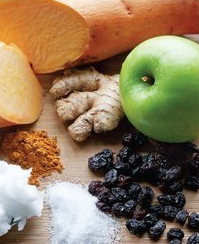We teach in yoga that every breath counts, so why not make every bite count?
Let’s consider a new approach to eating where we crowd out the bad with the good and learn to invest in and savor clean, beautiful, delicious and nutritious food – get a Big Bang for Your Bite!
Eat Nutritious
Balance your plate with whole and real food: fill half your plate with nutrient-dense produce and divide the other half into two parts: one for complex carbs like grains and potatoes, and the other for protein like beans, tofu, fish, eggs, poultry, or meat (if indulging).
When eating grains, choose whole and unrefined like brown rice, quinoa, spelt, and others to ensure adequate fiber and low glycemic impact. Look beyond the ‘nutrition facts’ and read the ingredient list to minimize white flour, refined sugar, corn syrup and HFCS (high fructose corn syrup), hidden sugars, and empty calories. Avoid processed and packaged foods which are not only devoid of nutrition but also typically high in chemicals like artificial flavors and preservatives, sodium, ‘bad’ fats, and GMOs.
A balanced plate goes beyond calories and fat grams to emphasize nutrient density – vitamins, minerals, phytonutrients, fiber, protein, carbs, and fat.
Eat Clean
Focus on eating clean food that is free from toxins that may burden your liver, endocrine system, and negatively impact gut health.
According to the Environmental Working Group, if we invest in clean versions of the Dirty Dozen, which are produce items with the highest level of chemical residues, we can decrease our toxin load by nearly 90%. Aim for organic or local sustainably-grown versions of the Dirty Dozen: apples, bell peppers, berries, celery, cucumbers, grapes, lettuce, nectarines/peaches, potatoes, green beans, spinach/kale, and other leafy greens.
When eating out and on the run, aim for the Clean 15 produce items with the lowest levels of chemical residue. These are: asparagus, avocado, cabbage, melons, sweet corn (watch out for corn, though, as they are one of the commonly genetically modified crops), eggplant, grapefruit, kiwi, mangoes, mushrooms, onions, pineapples, sweet peas, and sweet potatoes.
(Check out the EWG guide or download the app here)
Over 80% of our soybean crops are genetically-engineered (or GMO), so seek organic or GMO-free versions of these to avoid their side effects and potential pesticide residues.
If you choose to consume animal products, buy organic to avoid GMO
We eat with our eyes first, so indulge in gorgeous colors from the whole rainbow. Each naturally-occurring color correlates to specific age- and disease-fighting antioxidants and phytonutrients. Studies suggest certain plant chemicals or phytonutrients maintain health by boosting the immune system, reducing inflammation and allergies, detoxifying contaminants and pollutants, and/or activating enzymes that block unbridled cell division. Source
Aim to eat a variety of colors each meal or each day – green, yellow, orange, red, blue and purple.
• Green
Support your liver by eating dark leafy greens to help detox your body. Protect your eyes with lutein, which can be found in green vegetables like broccoli, spinach, kale, green peas, and turnip greens.
• Orange and Yellow
Orange and yellow foods contain carotenoids which may reduce the risk of cancer. Examples are pumpkin, mango, corn, sweet potato, carrots, cantaloupe, papaya, yellow peppers, and yellow beans.
• Red
Add red and you’ll be eating lycopene which may protect the heart and prevent cancer; consider tomatoes, guava, watermelon, papaya, and pink grapefruit.
• Blue and purple
These foods contain anthocyanins which suppress tumor formation and growth. Eggplant, blackberries, blueberries, cherries, red grapes, pomegranates, plums, and red onions are great choices.
• White
Cauliflower is a super cancer-fighter while white potatoes are rich in Vitamin C. Garlic and onions are super immune boosters linked to a lower risk of some cancers.
Shop local farmers’ markets and farm stands to get the most beautiful (and best-tasting) in season fruits and vegetables.
Eat Delicious
Ensure that what you eat is delicious and full of flavor by using fresh herbs, spices, good-quality oils, and even fun condiments like hot sauces and vinegars, instead of sugar, salt, and artificial sweeteners (which can increase your cravings and lead to other nasty side effects).
Try anti-inflammatory turmeric, digestion-boosting ginger, blood-sugar regulating cinnamon, immune-boosting oregano, and metabolism-increasing cayenne pepper.
Include healthy oils like olive, sesame, pumpkinseed, and grapeseed (especially great for high-heat cooking).
Add pizzazz with raw or toasted nuts, vinegars, salsas, mustards, tapenades, hot sauces, and other condiments plus natural sweeteners like stevia, honey or maple syrup (in moderation). Watch for sugar and HFCS which are the top ingredients in ketchup and BBQ sauces.
Count chemicals instead of calories.
Minimize toxins and maximize nutrition, beauty, and flavor so we all look and feel our very best, both on and off the yoga mat.
Red Jen Ford is a Certified Holistic Health Coach, Yoga Instructor and Seasonal Eating Expert. Jen teaches her clients the benefits and simplicity of eating local, sustainably grown food. Enjoy more of her dishes in her seasonal recipe booklets or her online course, Simply in Season: Recipes to Celebrate Healthy, Easy Seasonal Food.


